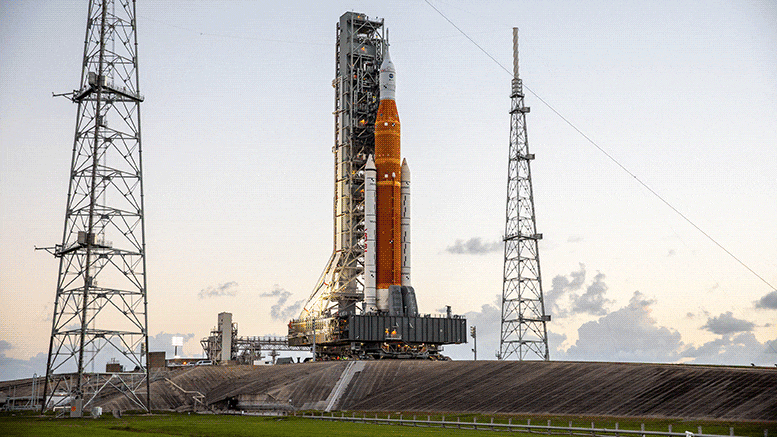NASA’s Space Launch System (SLS) rocket and the Orion spacecraft with its European Service Module, arrive at Launch Pad 39B at NASA’s Kennedy Space Center in Florida, USA, on November 4, 2022. The Artemis I mission will be the first test of SLS, Orion, and the European Service Module. Credit: NASA/Kim Shiflett
The Artemis I mega Moon rocket is on the launch pad at NASA’s Kennedy Space Center in Florida. This powerful Space Launch System (SLS) rocket is getting ready to launch the Orion spacecraft and its European Service Module. The first opportunity for launch is November 16 at 1:04 a.m. EST/local time (07:04 CET, 06:04 GMT).
Artemis I is the first mission in a large program to send astronauts around and on the Moon sustainably. This uncrewed first launch will see the Orion spacecraft travel to the Moon, enter an elongated orbit around our satellite, and then return to Earth. The Orion spacecraft is powered by the European-built module that supplies electricity, propulsion, fuel, water, and air in addition to keeping the spacecraft operating at the right temperature.

Artemis I mission overview. Orion is NASA’s next spacecraft to send humans into space and is part of the Artemis program. It is designed to send astronauts farther into space than ever before, beyond the Moon and to the lunar Gateway. Credit: ESA–K. Oldenburg
Artemis to the Moon
The European Service Modules are made from components supplied by over 20 companies in ten European Space Agency (ESA) Member States and the United States. As the first European Service Module sits atop the SLS rocket on the launchpad, the second is only 8 km (5 miles) away, as it is currently being integrated with the Orion crew capsule for the first crewed mission – Artemis II. The third and fourth European Service Modules – that will power astronauts to a Moon landing – are in production in Bremen, Germany.

Contributions in Europe for the European Service Module that is powering the Artemis missions around the Moon. Credit:
ESA–K. Oldenburg
The Artemis program is an international endeavor to build a permanent outpost around and on the Moon. Modules for the lunar Gateway are being built in the United States and Europe, with the first European module – International Habitat – in production in Turin, Italy, and set for launch on the fourth Artemis mission alongside the Orion spacecraft.
The first Artemis launch this week is without humans, but three mannequins have been placed in the spacecraft’s seats to conduct scientific research. Fitted with more than 5600 sensors, two mannequins will measure the amount of radiation astronauts could be exposed to in future missions with unprecedented precision. ESA is also including active radiation dosimeters in the Crew Module to get more data on how radiation levels change on a mission to the Moon – building on the leadership developed over decades of radiation research on the International Space Station.

Logo for the first European Service Module (ESM) that is powering NASA’s Orion spacecraft to send humans into space and the Moon as part of the Artemis program. Credit: ESA
Dates
With a November 16 launch, the three-week Artemis I mission would end on December 11 with a splashdown in the Pacific Ocean. The European Service Module detaches from the Orion Crew Module before splashdown and burns up harmlessly in the atmosphere, its job complete after taking Orion to the Moon and back safely.
Backup Artemis I launch dates include November 19. Watch the launch live on ESA Web TV.
The Orion spacecraft with European Service Module will fly farther from Earth than any human-rated vehicle has ever flown before. This video gives an overview of the first mission – without astronauts – for Artemis, focusing on ESA’s European Service Module that powers the spacecraft. The spacecraft will perform a flyby of the Moon, using lunar gravity to gain speed and propel itself 70,000 km beyond the Moon, almost half a million km from Earth – further than any human has ever traveled, where it will inject itself in a Distant Retrograde Orbit around the Moon. On its return journey, Orion will do another flyby of the Moon before heading back to Earth. The total trip will take around 20 days, ending with a splashdown in the Pacific Ocean without the European Service Module – it separates and burns up harmlessly in the atmosphere. Credit: ESA – European Space Agency
Share your story or advertise with us: Whatsapp: +2347068606071 Email: info@newspotng.com











